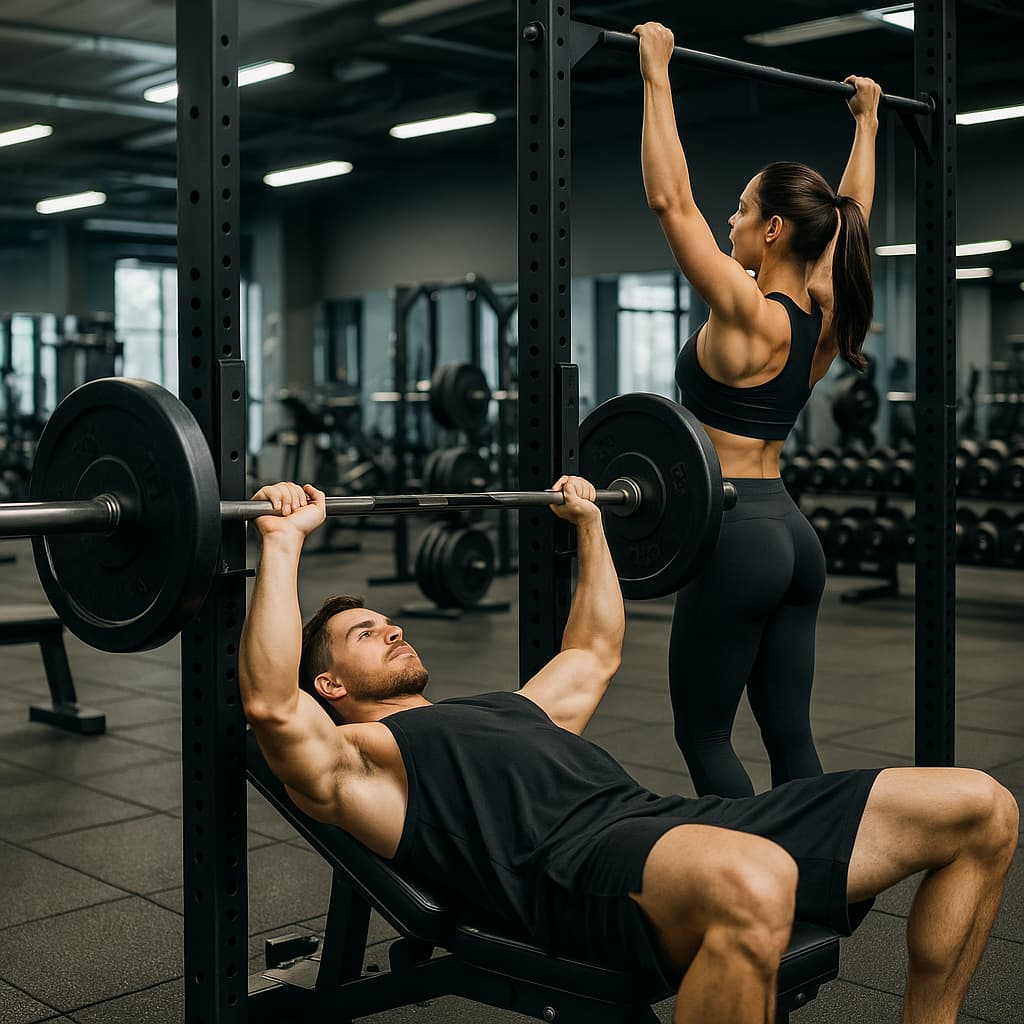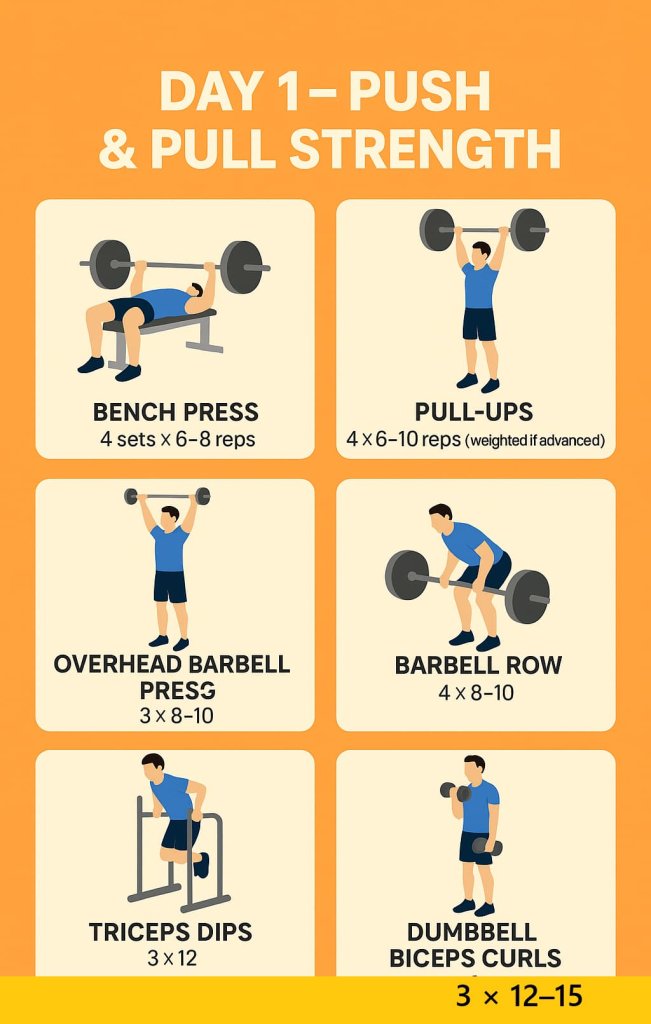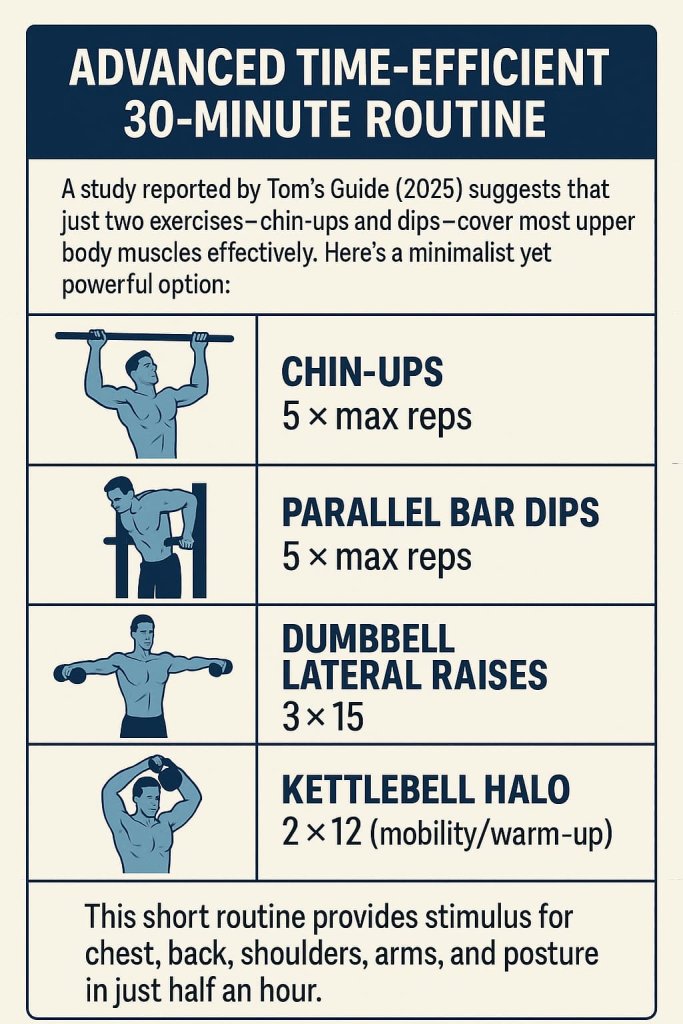The best upper body workout routine combines compound lifts, isolation movements, and stability exercises to target your chest, back, shoulders, biceps, and triceps.
If you want a stronger, more muscular, and better-balanced body, focusing on upper body training is essential. A good routine improves posture, boosts athletic performance, prevents injuries, and builds the V-shaped physique many people aim for.

This guide provides everything you need:
- Science-backed workout structure (push, pull, flexion, extension).
- Sample workout plans for beginners, intermediates, and advanced lifters.
- Form cues, sets, and reps for each movement.
- YouTube tutorials so you can train with confidence.
Let’s break down the ultimate way to build your upper body in 2025.
Why Upper Body Workouts Are So Important

Training your upper body does far more than just build arm size. A complete routine gives you:
- Strength for daily life – From carrying groceries to lifting furniture, a stronger chest, back, and shoulders make everyday activities easier.
- Better posture – Pulling exercises (rows, pull-ups) strengthen the back, balancing out pressing movements and reducing rounded shoulders.
- Injury prevention – Stability moves like face pulls protect shoulders and prevent overuse injuries.
- Balanced aesthetics – Wide lats, a strong chest, and defined shoulders create the ideal V-taper shape.
👉 Experts recommend training all six movement categories (horizontal push, vertical push, horizontal pull, vertical pull, elbow flexion, and elbow extension) for the most balanced results【aworkoutroutine.com】.
Key Training Principles for Upper Body Success
1. Weekly Training Volume
- Chest & Back: 10–20 sets per week
- Shoulders, Biceps, Triceps: 5–10 sets each
2. Training Frequency
- 2–3 sessions per week ensures growth and recovery balance.
3. Rep & Rest Guidelines
- Strength: 4–6 reps, rest 2–3 minutes.
- Hypertrophy (muscle size): 8–12 reps, rest 60–90 seconds.
- Endurance: 12–15+ reps, rest 30–60 seconds.
4. Progressive Overload
- Add weight, reps, or sets over time.
- Track progress weekly.
The Best Upper Body Workout Routine (Sample Plan)

Day 1 – Push & Pull Strength
This day emphasizes compound lifts to build raw strength and overall muscle mass. Focus on controlled reps, good form, and progressive overload.
- Bench Press – 4 sets × 6–8 reps
- Targets: Chest, shoulders, triceps.
- Form tip: Keep feet flat, slight arch in lower back, and lower bar to mid-chest before pressing up powerfully.
📺 Watch: How to Bench Press Properly (Jeremy Ethier)
- Pull-Ups – 4 × 6–10 reps (weighted if advanced)
- Targets: Lats, biceps, upper back.
- Form tip: Full range of motion—chin over bar at the top, arms extended at the bottom. Add a dip belt for progression.
📺 Watch: The Perfect Pull-Up (Buff Dudes)
- Overhead Barbell Press – 3 × 8–10
- Targets: Shoulders, triceps, core.
- Form tip: Stand tall, core braced, and press overhead without arching back. Keep wrists stacked over elbows.
📺 Watch: Overhead Press Tutorial (Athlean-X)
- Barbell Row – 4 × 8–10
- Targets: Lats, traps, rhomboids, rear delts.
- Form tip: Maintain flat back, hinge at hips, and pull bar toward torso. Control both lifting and lowering.
📺 Watch: Barbell Row Form Guide (Scott Herman Fitness)
- Triceps Dips – 3 × 12
- Targets: Triceps, chest, shoulders.
- Form tip: Use parallel bars, elbows tucked, and lean slightly forward if you want more chest activation.
📺 Watch: How to Do Dips Correctly (Mind Pump TV)
- Dumbbell Biceps Curls – 3 × 12–15
- Targets: Biceps.
- Form tip: Avoid swinging weights—curl slowly, squeeze at the top, and lower under control. Alternate grips (hammer/supinated) for variation.
📺 Watch: Perfect Bicep Curl Form (Jeremy Ethier)
👉 This session combines push and pull patterns, ensuring balanced development of chest, shoulders, back, and arms. Aim to increase either weight or reps weekly for steady progress.
Day 2 – Hypertrophy & Stability

This session emphasizes controlled reps, higher volume, and stability-based moves to enhance muscle definition and durability.
- Incline Dumbbell Press – 4 × 8–10
- Targets: Upper chest and shoulders.
- Form tip: Keep bench at 30–45°, wrists stacked over elbows, and press smoothly without locking out harshly.
📺 Watch: Incline Dumbbell Press (Scott Herman Fitness)
- Lat Pulldown – 4 × 10–12
- Targets: Lats and back width.
- Form tip: Pull bar to upper chest, control lowering phase, and avoid leaning too far back.
📺 Watch: Lat Pulldown Form Guide (Jeremy Ethier)
- Seated Dumbbell Shoulder Press – 3 × 10–12
- Targets: Shoulders and triceps.
- Form tip: Sit upright, press dumbbells overhead in a controlled motion, and don’t flare elbows too wide.
📺 Watch: Seated Shoulder Press (Mind Pump TV)
- Face Pulls – 3 × 12–15
- Targets: Rear delts, traps, and rotator cuffs.
- Form tip: Use a rope attachment, pull toward face with elbows high, and squeeze shoulder blades together.
📺 Watch: Face Pulls Explained (Athlean-X)
- Skull Crushers – 3 × 10–12
- Targets: Triceps.
- Form tip: Lower bar or dumbbells slowly toward forehead, then extend powerfully while keeping elbows steady.
📺 Watch: Skull Crusher Tutorial (Scott Herman Fitness)
- Farmer’s Carries – 3 × 40–60 sec
- Targets: Grip, traps, forearms, and core stability.
- Form tip: Hold heavy dumbbells/kettlebells, walk tall with braced core, and avoid leaning sideways.
📺 Watch: Farmer’s Walk Tutorial (Buff Dudes)
👉 Perform each workout twice per week (total 2–3 sessions).
Beginner-Friendly Upper Body Workout

If you’re just getting started with strength training, the key is to master bodyweight movements and light dumbbell exercises before moving on to heavier lifts. This routine focuses on simple, safe, and effective movements that lay the foundation for long-term progress.
1. Push-Ups – 3 × 12
- Muscles worked: Chest, shoulders, triceps, and core.
- Form tip: Keep your body in a straight line from head to heels. Lower your chest close to the ground, elbows tucked at about 45°.
- Progression: If regular push-ups are too difficult, start on your knees or against a wall/bench. To make them harder later, try incline or weighted push-ups.
📺 Watch: Perfect Push-Up Tutorial (Athlean-X)
2. Inverted Rows – 3 × 10
- Muscles worked: Back, lats, biceps, and rear delts.
- Form tip: Use a bar or TRX straps. Keep your body rigid like a plank and pull your chest toward the bar. Avoid shrugging shoulders.
- Progression: Start with higher bar placement (easier), then gradually lower the bar to increase difficulty. Eventually, you’ll build strength for pull-ups.
📺 Watch: Inverted Row Tutorial (Jeff Nippard)
3. Dumbbell Shoulder Press – 3 × 10–12
- Muscles worked: Shoulders (delts) and triceps.
- Form tip: Sit or stand tall, brace your core, and press dumbbells overhead without arching your back. Keep wrists straight and aligned.
- Progression: Start light and focus on control. Over time, increase dumbbell weight or switch to standing presses to challenge balance and stability.
📺 Watch: Dumbbell Shoulder Press Form (Scott Herman Fitness)
4. Bicep Curls – 2 × 12
- Muscles worked: Biceps.
- Form tip: Keep elbows close to your torso, curl slowly, and avoid swinging. Squeeze the biceps at the top for maximum activation.
- Progression: Start with light dumbbells or water bottles. Gradually add weight or try hammer curls to target different parts of the biceps.
📺 Watch: Bicep Curl Tutorial (Jeremy Ethier)
5. Triceps Bench Dips – 2 × 12
- Muscles worked: Triceps (back of the arms) and chest.
- Form tip: Place your hands on a sturdy bench or chair, feet flat, and lower yourself until elbows reach ~90°. Press back up without locking out completely.
- Progression: Bend knees to make it easier, or straighten legs and add a backpack in your lap for more resistance later.
📺 Watch: Bench Dip Tutorial (Mind Pump TV)
Pro Tips for Beginners
- Warm up first: 5 minutes of arm circles, band pull-aparts, or light cardio to get blood flowing.
- Start light: Focus on form before adding weight.
- Train 2–3 times per week: Allow at least one rest day between sessions.
- Track your progress: Write down reps and sets to see improvements.
- Stay consistent: Muscle and strength changes appear in 4–6 weeks with regular effort.
👉 Tip: Planet Fitness suggests that if you don’t have access to equipment, you can substitute dumbbells with filled water bottles, backpacks, or household objects to create resistance【planetfitness.com】.
Advanced 30-Minute Upper Body Routine

For those with busy schedules, you don’t always need long gym sessions to get results. A minimalist upper body routine can be highly effective if you focus on compound moves that hit multiple muscle groups at once. According to Tom’s Guide (2025), a combination of chin-ups and dips alone can train nearly every major upper body muscle. By adding accessory lifts for shoulders and mobility, you can create a balanced, full workout in just 30 minutes.
1. Chin-Ups – 5 × max reps
- Muscles worked: Lats, biceps, upper back, forearms, and core.
- Form tip: Hang with arms fully extended, pull until chin clears the bar, and lower under control. Avoid swinging or kipping for strict strength.
- Progression: Add weight with a dip belt once you can do 10–12 clean reps. If too difficult, use resistance bands for assistance.
📺 Watch: Perfect Chin-Up Tutorial (Athlean-X)
2. Parallel Bar Dips – 5 × max reps
- Muscles worked: Chest, triceps, and shoulders.
- Form tip: Keep torso slightly forward for chest emphasis, or upright to hit triceps more. Lower until elbows reach ~90° and push back up explosively.
- Progression: Use a weighted dip belt for added resistance, or keep legs tucked for easier variation.
📺 Watch: How to Do Dips Correctly (Mind Pump TV)
3. Dumbbell Lateral Raises – 3 × 15
- Muscles worked: Side delts (shoulder width).
- Form tip: Raise dumbbells slightly in front of your body, not directly out to the sides, to protect shoulder joints. Keep a slight bend in elbows and control both lifting and lowering.
- Progression: Increase weight gradually or try drop sets (reduce weight mid-set) for extra burn.
📺 Watch: Lateral Raise Form Guide (Jeremy Ethier)
4. Kettlebell Halo – 2 × 12 (each direction)
- Muscles worked: Shoulders, traps, arms, and core stabilizers.
- Form tip: Hold the kettlebell upside down (horns up), rotate it around your head in a smooth circle, keeping abs braced and movements controlled.
- Why it matters: Improves shoulder mobility, posture, and joint health—perfect if you sit at a desk for long hours.
📺 Watch: Kettlebell Halo Tutorial (Ben Bruno)
Why This Routine Works
- Efficiency: Only 4 exercises target every major upper body muscle.
- Strength + Hypertrophy: Chin-ups and dips are compound moves for maximum overload, while lateral raises sculpt shoulders and halos improve mobility.
- Flexibility: Can be done in a gym, home setup (with a pull-up bar and dip station), or even outdoors.
👉 Perform this workout 2–3 times per week on non-consecutive days. Keep rest periods short (60–90 seconds) to stay within 30 minutes.
Warm-Up & Mobility Essentials
Warming up improves performance and prevents injury:
- Arm Circles – 30 sec each direction
- Band Pull-Aparts – 2 × 15
- Shoulder Dislocates – 2 × 12
- Scapular Pull-Ups – 2 × 8
- Kettlebell Halo – 2 × 12 (great for posture and shoulder mobility)
📺 Watch: Kettlebell Halo Tutorial (Ben Bruno)
Quick Reference Table
| Movement Type | Best Exercise Options |
|---|---|
| Horizontal Push | Bench Press, Push-Ups, Incline DB Press |
| Vertical Push | Overhead Press, Seated DB Press |
| Horizontal Pull | Barbell Row, Seated Row |
| Vertical Pull | Pull-Ups, Lat Pulldown |
| Elbow Flexion | Bicep Curls, Hammer Curls |
| Elbow Extension | Dips, Skull Crushers |
| Stability/Core | Farmer’s Carry, Kettlebell Halo |
FAQs on Upper Body Training
1. How often should I train my upper body?
2–3 times per week works best for strength and hypertrophy.
2. Do push and pull need to be trained together?
Yes, combining both prevents imbalances and posture issues.
3. Can I build muscle without a gym?
Yes—push-ups, pull-ups, dips, and bodyweight rows are excellent.
4. What’s the best rep range for muscle growth?
8–12 reps per set is the sweet spot for hypertrophy.
5. How long until I see results?
Beginners often notice strength gains in 3–4 weeks and visible changes in 6–8 weeks.
6. Should I isolate arms separately?
Not necessary if you’re doing push/pull work, but curls and extensions can enhance growth.
7. What if I only have 30 minutes?
Do the advanced short routine: chin-ups, dips, raises, and halos.
Conclusion
The best upper body workout routine balances push, pull, and isolation work for complete development. By training 2–3 times per week, progressively overloading your lifts, and focusing on proper form, you’ll build strength, size, and durability.
👉 Pick one of the routines above, stick with it for 8 weeks, and you’ll see significant improvements in strength, definition, and confidence. Pair your training with good nutrition and rest for maximum results.
